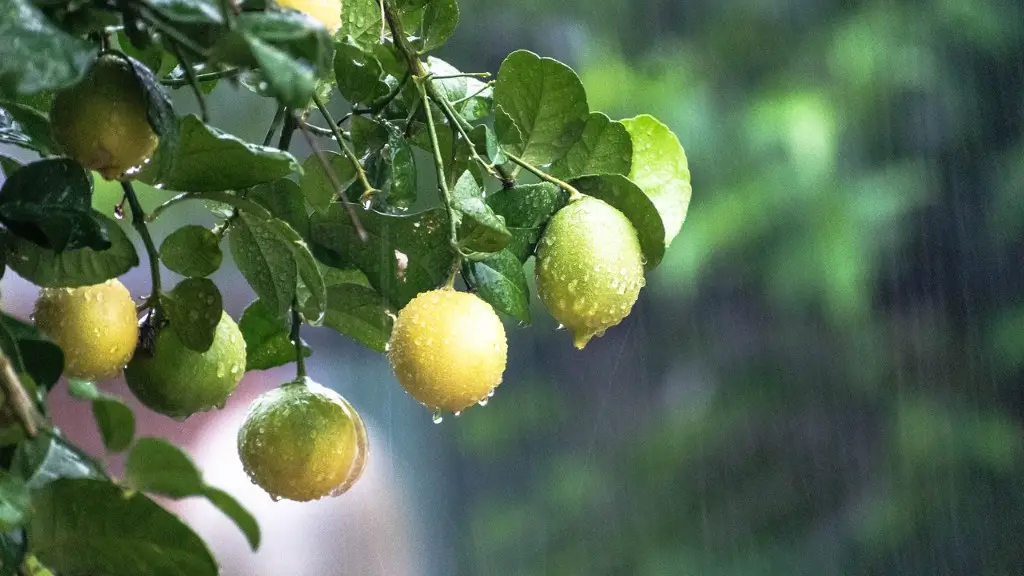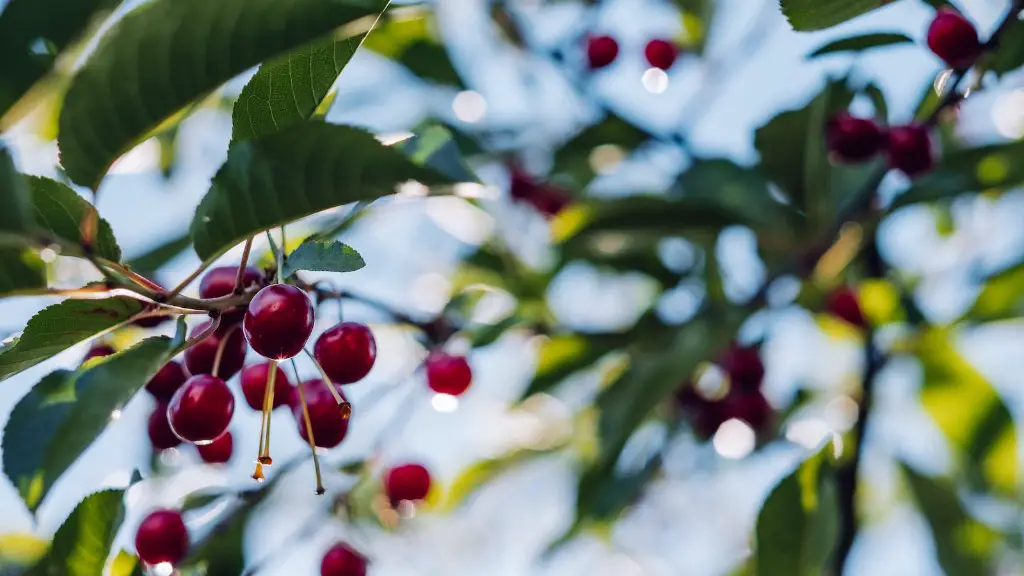Growing a cherry tree from cherries is a thoughtful, rewarding activity that anyone can undertake. It’s a fun way to bring the outdoors into your home and garden, nurture the environment and ensure that the farmers’ market cherries grow in abundance for generations. Getting started is not difficult, it just takes some patience and a little knowledge to become an expert at cherry tree growing.
To grow a cherry tree from cherries, the basics are simple. All you need is a handful of cherries, a few tools, and an area of land with plenty of sun and well-drained soil. Start by planting your cherry pits a few inches deep in the soil. As the shoots begin to emerge from the pits, you can begin to prune the cherry tree to encourage healthy growth. Pruning helps to keep the tree in its proper shape, as well as to control pests and fungi. It is also important to keep the trees well watered throughout the growing season.
Cherry trees require plenty of nutrition to thrive. An understanding of fertilizers and soil amendments is essential for any successful cherry grower. A balanced fertilizer with phosphorus, nitrogen, and potassium is best for general health. An acidifying fertilizer that supplies sulfur, as well as additional nitrogen, calcium and organic matter, will also promote healthy growth. Additionally, bi-annual applications of well-composted organic matter can provide additional nutrients necessary for fruiting.
Cherry trees are susceptible to a variety of diseases and pests. Knowing how to identify each, as well as how to treat and prevent them, is important to successful cherry tree growing. While many pests can be managed with sprays and other treatments, some, such as Japanese beetles and tent caterpillars, can be quite destructive and require professional skills for elimination. Knowing when and how to prune your cherry tree can also help protect it from diseases, as proper pruning removes weak wood and helps increase air circulation between the branches.
Growing a cherry tree from cherries can be a rewarding experience. Once established, a cherry tree can produce abundant harvests for years, and can serve as a centerpiece for an attractive landscape. By taking the time to learn more about planting, pruning and caring for a cherry tree, you can have the satisfaction of harvesting your very own cherry tree for many years to come.
Pruning Techniques
When pruning your cherry tree, it is important to be aware of a few basic techniques. Pruning can help keep your tree healthy and will help stimulate new growth. The three main pruning types are crown thinning, crown lifting and heading, and deadwood removal. Crown thinning involves removing some branches from the top of your tree to ensure that light and air can reach the inner parts of the tree. Crown lifting, or raising, will remove the lower branches that can block walkways and prevent sunlight from reaching the lower parts of the tree. Heading involves cutting back branches to reduce the height of your tree. Finally, deadwood removal involves removing dead or broken branches to prevent the spread of disease.
When pruning your tree, it is important to avoid cutting the main trunk or the main branches. Also, be careful not to over-prune, as this can cause damage to the tree and reduce its vigor. Following these simple guidelines will help to ensure your cherry tree remains healthy and vigorous.
Harvesting Cherries
Harvesting your cherry tree’s bounty is easy and fun. When harvesting cherries, you should choose fruit that is firm, plump and brightly colored. When picking, be sure to leave some fruit on the tree for the birds and other wildlife. Once the cherries are picked, they can be eaten fresh, cooked, canned or frozen for later use. Cherries also make a great addition to jams, jellies and other recipes.
To ensure a good harvest, you should water your cherry tree generously and apply a balanced fertilizer regularly. Regular mulching will also ensure that the soil around your cherry tree remains moist and will help prevent weeds from stealing the moisture from your tree. Finally, pest and disease control should be done regularly to ensure a healthy harvest.
Shaping Your Cherry Tree
The shape of your cherry tree is important to its health, growth and harvest potential. Properly shaping or training your tree can also make it easier to prune, protect against disease, and make harvesting easier. Carefully inspect your tree and its branches to determine if any pruning or training needs to be done. You can do this by looking for any branches that are miscolored, dead, or growing at the wrong angle.
When shaping your tree, ensure that the branches are evenly spaced and that there is good clearance from any nearby structures. The tree should be evenly balanced, with the lowest branches no more than 18 inches above the ground. Strong central leaders should be identified and developed, and weak or dead branches should be removed to allow for good ventilation and disease prevention. When finished, your cherry tree should have an overall balanced, symmetrical shape.
Preserving Cherries
Preserving your cherry tree’s bounty is simple and will ensure that you can enjoy its delicious fruit year-round. First, it is best to harvest your cherries as soon as they are ripe. They can then be refrigerated or frozen for use in a variety of dishes. Alternatively, you can dry the cherries to make them last longer. To do this, lay the cherries on a dehydration sheet and place in an oven set to its lowest temperature. Once the cherries are dried, they can be stored in an airtight container.
Cherries can also be canned and preserved in a variety of ways. Start by sterilizing your jars, lids and seals. To can the cherries, place them in the jar and pour the boiling syrup over them. The lid should then be fitted onto the jar and sealed. Once sealed, the jars can be processed in a hot water bath for about 15 minutes. Lastly, the jars should be cooled and stored in a cool, dark place.
Choosing The Right Variety
When choosing the variety of cherry trees for your garden, it is important to consider the size, flavor, and hardiness of the fruit, as well as the growing conditions of your location. Different types of cherry trees can be grown in different parts of the country. Sweet cherries, such as Bing and Lambert, are especially popular in the west, while tart cherries, such as Montmorency and North Star, are best in the northern climates. Additionally, dwarf varieties, such as Dwarf North Star and Nanking, are a great choice if you want a tree that won’t grow too big.
No matter which variety you choose, be sure to select healthy trees that are suited to your climate. You can often find local nurseries or tree farms that specialize in cherry trees, which can be a great source for finding a variety that is well suited to your area. With a little research, and some patience and care, you can be the proud grower of a beautiful, productive cherry tree.
Cherry Tree Care
Once planted, there are a few key steps to ensure that your cherry tree remains healthy and productive. During the first few years of its life, your cherry tree will need plenty of water and fertilizer to help promote healthy growth. Water your tree regularly and deeply during the summer months, and avoid providing too much nitrogen, as this can cause excessive growth. Additionally, prune and shape your tree regularly, as this will help to control its size and give it a better shape.
In the winter months, it is important to protect your tree from frost and snow. Protective covers, such as blankets, can be used to provide additional insulation when necessary. Additionally, mulching your tree in the spring will not only provide added protection from cold temperatures, but it can also nourish your tree with nutrients and help retain moisture. Finally, frequent inspections for pests, diseases, and damage can help to keep your tree healthy and productive.
Enjoying Your Cherry Tree’s Bounty
Once you have grown and cared for your cherry tree, you will be rewarded with a bountiful harvest of delicious cherries each year. There are many ways to enjoy cherries, whether they are eaten fresh, cooked into dishes, or used to make jams and jellies. You can also use the cherries to make delicious cherry pies or homemade wine. With a little creativity and a love of cherries, you can help your harvest last throughout the year.
Cherries are also a nutritious snack that can be enjoyed in many different forms. Have some cherries as an afternoon snack, add them to a salad or mix them into a smoothie. You can also freeze cherries to use as a refreshing treat in the summer months. No matter how you decide to enjoy your cherry tree’s bounty, the fruit of your labor can be savored for months.
Gifting Your Cherry Tree’s Bounty
Once your cherry tree is in full bloom, you may be left with an abundance of cherries. Rather than eating them all yourself, why not gift your cherry tree’s bounty to friends and family? There are many ways to make your cherries unique, such as making homemade cherry jam or cherry sauce. These can be used as delicious ingredients in a variety of recipes, or as a special treat. You can also gift a basket of cherries complete with a recipe or two that are sure to bring some joy.
Gifting cherries is also a great way to spread awareness of your cherry tree and your eco-friendly efforts. You may even find that you can gain a few followers who are interested in joining you on your eco-friendly journey and learning about sustainable farming. Gifting your cherry tree’s bounty is a great way to foster relationships and share in the delight of your harvest.
Selling Your Cherry Tree’s Bounty
If you find that your cherry tree’s bounty is too plentiful to be enjoyed by yourself, you can also sell your cherries to make some extra money. Not only is this a great way to make extra cash, but it is also a great way to contribute to your local economy. Consider selling your cherries at local farmers’ markets or, if you have the necessary permits and licenses, you could even sell your cherries online.
Before you begin to sell your cherries, it is important to make sure that you are following all of the necessary health and safety regulations, as well as any local laws. Additionally, you should make sure that your cherries are packaged properly and labeled correctly to ensure that your customers receive a safe and quality product. By following these steps and offering quality cherries, you will be sure to have a successful cherry business.
Cherish Your Cherry Tree
Growing a cherry tree from cherries is a rewarding endeavor that pays off in both tasteful rewards and emotional satisfaction. Along the way, you can learn about pruning techniques, soil amendments, pests, and diseases. With a little knowledge and care, your cherry tree can become an integral part of your garden for generations to come.
Enjoying your cherry tree does not have to be limited to picking its fruits. Spend time sitting next to your tree and observe its changes throughout the seasons. Notice the changes in its leaves, its new growth, the way it shapes your landscape. Cherish it and it will provide you with joy and a bounty of delicious fruit.


